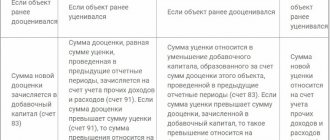The procedure for calculating depreciation of fixed assets in accounting
Depreciation involves the gradual inclusion in expenses of the cost of fixed assets, which is a significant amount for any organization. Fixed assets can participate in generating income for a long time and have a long service life.
Depreciation of fixed assets must be calculated for all groups. But some of the property does not need to be depreciated:
- if the initial cost is within the limits of the maximum value not exceeding 40,000 rubles. (clause 5 of PBU 6/01) (if these objects are accepted for accounting as inventories);
- if the object is on the list of property for which depreciation is not accrued (clause 17 of PBU 6/01).
Read about non-depreciable fixed assets in the material “Rules for calculating depreciation of non-current assets”.
PBU 6/01 is the main document that establishes the rules for calculating depreciation of fixed assets in accounting. When accepting for accounting for each individual object, the organization determines the depreciation procedure based on PBU 6/01 and fixes the parameters: the method of calculating depreciation of fixed assets , and their useful life.
Read about the basic rules for calculating depreciation of fixed assets in the already familiar material “Rules for calculating depreciation of non-current assets.”
Changes in budget accounting since 2018
Changes in budget accounting in 2020 affect the area of fixed asset accounting.
For an accountant of a budgetary institution, one of the main documents is Order of the Ministry of Finance of the Russian Federation dated December 1, 2010 No. 157N. In the accounting environment, it is simply called instruction No. 157n.
This document contains the chart of accounts for budget accounting 2020 and instructions for its use.
Any operation of a budgetary institution must be accompanied by an entry made in accordance with instruction No. 157N on budget accounting for 2020.
From 01/01/2018, in addition to the specified instructions, the Federal Accounting Standard “Fixed Assets” appeared (Order of the Ministry of Finance of Russia dated 12/31/2016 No. 257n).
New criteria for fixed assets
Accounting for fixed assets in budgetary institutions must be carried out based on the new standard.
The emerging standard explains in detail in which cases objects can be included in budget accounting as fixed assets.
New criteria:
- The value of the property must be reliably estimated. In budgetary organizations, the law allows you to immediately write off objects less than 10,000 rubles from the balance sheet. In commerce this criterion is much higher.
- Fixed assets in budget accounting must generate money and must be suitable for work. Otherwise, the objects should be accounted for in off-balance sheet budget accounts.
The standard clarifies that biological assets, real estate for sale, and state treasury property cannot be classified as fixed assets.
According to clause 12 of the Federal Standard, a cultural heritage asset is recognized as a fixed asset if:
- it is possible to receive income or useful potential in the future;
- the useful potential lies not only in cultural value.
It is important that at least one of two conditions is met. If the conditions are not met, the accountant must transfer the cultural heritage asset to an off-balance sheet account, valuing it at one ruble.
Requirements for assessing objects
The procedure for determining the initial cost depends on the type of operation. The standard introduces two categories of such transactions: exchange and non-exchange.
In exchange transactions, a budgetary institution acquires a fixed asset for money or in exchange for other assets comparable in value to the acquired values. The initial cost will be equal to the amount of actual costs.
In non-exchange transactions, a budget institution receives property as a gift or for a nominal fee. The initial cost in this case is equal to the fair value of the object (market value).
How to group objects
The classification of fixed assets by their types has changed slightly. These changes have already been made to instruction No. 157n.
The groups “Non-residential premises” and “Structures” were combined into one. Some subtypes of fixed assets in budget accounting 2020 have been moved to the “Other” group.
The groups “Investment real estate” (account 0 10103 000) and “Biological resources” (account 0 10107 000) appeared.
The accountant of a budgetary institution should check whether the accounting of fixed assets complies with the new rules. If necessary, move objects between groups. The transfer should be made by posting using account 0 401 30 000. The operation should be reflected in the accounting certificate as of 01/01/2018.
Which depreciation method to choose
Previously, public sector employees could only depreciate property using the straight-line method.
The standard added two more options for calculating depreciation:
- Reducing balance method. Effectively used for rapidly wearing out and obsolete fixed assets.
- Method of calculating the amount of depreciation proportional to the volume of production. It is beneficial to use if it is known how much product the institution will be able to produce thanks to this facility.
The depreciation method should be chosen based on the specifics and purpose of operation of the facility. Over time, the organization has the right to reconsider the selected method for a specific object (this can only be done at the beginning of a new calendar year).
The new standard does not allow stopping depreciation even for those objects that are temporarily not in use. Instruction on budget accounting No. 157n previously gave institutions such a right.
The limits on the value of fixed assets for their debiting from the balance sheet have changed. If the fixed asset is cheaper than 10,000 rubles, depreciation does not need to be calculated. If the cost of the object is in the range from 10,000 to 100,000 rubles, 100% depreciation is charged when the object is put into operation.
What has changed in reporting
With the introduction of the standard, new reporting requirements appeared.
A number of indicators need to be deciphered in reporting (clause 51 of the Federal Standard), including:
- depreciation methods;
- depreciation amounts (accrued, accumulated);
- price;
- cost of retired fixed assets, etc.
The listed information must be provided for each group of fixed assets.
How to get started with the new standard
Budgetary accounting of fixed assets in 2020 gives the accountant more options. But at the same time, in some places, accounting has become more difficult.
Work on the new standard began in 2020. For correct accounting, public accountants had to conduct an inventory and bring accounting into compliance with the norms of the analyzed standard.
Budget accounting has changed since 2020. To keep records correctly, you should use the new standard for fixed assets and instructions for budget accounting 2020. Changes in budget accounting will be reflected in the reporting for 2020.
Instruction No. 157n on budget accounting, as amended, has been in effect since the beginning of the year, the latest edition was issued on March 31, 2018.
Try it
Source: https://www.kontur-extern.ru/info/byudzhetnyj-uchet
https://youtu.be/3DwHo3VH0Tc
Example of calculating depreciation of fixed assets
Let's look at an example of how to calculate depreciation of fixed assets in practice.
Example
In January 2020, the organization accepted into operation an object with an initial cost of 72,000 rubles. The fixed useful life is 3 years (36 months).
The linear depreciation method chosen by the organization provides for the following calculation of the annual depreciation amount: 72,000 × 1 / 3 = 24,000. Here 1/3 is the depreciation rate. It is calculated based on the specified number of years of operation. In fact, the annual amount can be obtained by simply dividing the cost by the number of years; in practice, this is how the calculation is made.
The monthly depreciation amount is equal to the result of dividing the annual amount by the number of months in the year: 24,000 / 12 = 2,000. Or, which is equivalent, the result of dividing the original cost by the number of months of use: 72,000 / 36.
What to include in the OS
The standard provides for the reflection in the composition of fixed assets (on the corresponding analytical accounts of account 0 101 00 000 “Fixed Assets”) of material assets, regardless of their cost, with a useful life of more than 12 months, intended for repeated or permanent use by the subject of accounting with the right of operational management (the right to own and (or) use property arising under a lease agreement (property lease) or an agreement for gratuitous use) for the purpose of performing state (municipal) powers (functions), carrying out activities to perform work, provide services, or for the management needs of the subject of accounting , which are assets in accordance with the criteria established by the GHS Conceptual Framework.









